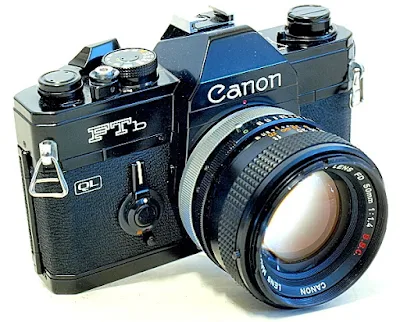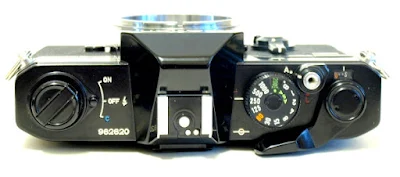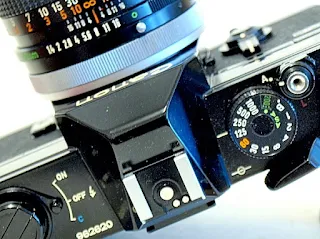Film Camera Review: A well-supported manual focus, and manual exposure 35mm SLR film camera with a strong pedigree.
The Canon FTb QL, a manual focus and manual exposure 35mm SLR film camera targeted at the consumer market, was launched in 1971 as a replacement for the Canon FT QL. The upgrade saw the FTb QL being fitted with the new FD lens mount system as a replacement to the older FL-mount which the original FT QL is fitted with.
The introduction was alongside the Canon F-1, the first professional-grade SLR system from Canon, which came with a fanfare of accessories and interchangeable parts. Though offering many of the same features, build quality, and the FD lens mount as the F-1, the Canon FTb QL did not have the option of having interchangeable prisms, focusing screens, or motor drive attachments.
On its own, however, the FTb QL is a unique version of Canon's camera lineup. The FTb QL comes fitted with the highly acknowledged SMS (Shockless Mirror System), which enables the shutter release without any vibration. The trigger pull is very smooth and has far less recoil when compared to any other SLR.
The camera is also fitted with Canon's QL (Quick Load) function, features including an ultra-sensitive CdS exposure meter, full aperture TTL metering, Canon Auto Tuning (CAT) System for automated flash photography, self-timer, multiple exposures, mirror lockup, stopped-down metering and the like, on an elegant body with all its functions laid simple and proper.
Canon FTB 35mm Film Camera Review
In this week's episode, I review the Canon FTb 35mm film camera. This one is fully manual (with the exception of a light meter): all cranks and dials. I've had a lot of fun shooting with the camera and it's produced some great results for me, in my opinion.
Operationally, the FTb QL has an all-mechanical horizontally traveling focal plane shutter with a shutter speed range from 1 to 1/1000 to 1 second, and Bulb, a 10-second delay self-timer, mirror lockup, a stop-down metering system that can be used for depth-of-field preview, and stop-down metering for older FL lenses. The film ISO setting is from 25 to 2000.
Exposure reading, through a switched control exposure metering system with a match-needle viewfinder readout, is off the 12% central rectangular area of the screen, a ground glass Fresnel with a center spot microprism. The screen has an image size coverage of 94%.
Basic Camera Features
This description is based on the Canon FTb-N, the final revised version of the camera, which is available both in chrome and black.
The front of the FTb QL is rather plain, aside from the Self-Timer/Stopped Down Metering/Mirror Lockup combination mechanism on the left of the lens mount housing, and on the right, the Flash Sync Socket, with a push-aside spring-loaded metal cover.
On the left of the pentaprism housing of the top plate is the Film Rewind Crank, which is integrated with the exposure metering On/Off/Battery Check selector lever. On the right is the Shutter Speed dial, which is integrated with the film ISO speed selector, Shutter Release housed on the Shutter Lock Lever, the Film Advance Crank, and the auto-reset Film Counter window.
The back, with a hinged QL film back, is plain. The battery chamber for the FTb QL is located on the left shoulder of the top plate, a very convenient design if you have an autowinder or a motor drive attached to the bottom plate of the camera. The FTb QL, however, is not designed for such an attachment.
The Tripod Socket, and the Rewind Release button in on the bottom plate.
What looks like a rather complicated QL mechanism covers the whole of the take-up spool area, occupying up to a third of the film box area, with its mechanism straddling across from the film box to the film back.
Film loading is, as expected, a matter of dropping the film spool in. extending the film lead to the red mark, closing the back, and firing off two blank shots.
Model Iteration
The design of the Canon FTb QL was revised slightly in 1973, with both cosmetic and engineering refinements, and a shutter speed dial display on the lower left-hand corner of the viewfinder, a tell-tale sign that the camera was the revised version. This model was unofficially known as FTb-N or FTbn.
Viewfinder Info
The viewfinder is a simple display of the image centered by a shaded rectangle (12% of the screen area) from which the exposure reading is taken, and a match needle (meter needle and aperture needle) displays within a couple of bracket blocks on the lower right side of the screen.
Matching the meter needle to align the aperture needle is all that it takes to set the image to its correct exposure.
A red flag pop-up will be displayed at the lower right corner of the display when the shutter is set to a slow speed that is beyond the limit of the meter's coupling range.
On the revised FTb-N model, a small dial with the shutter speed selection will be displayed at the lower-left corner of the viewfinder screen.
Manual Exposure Mode
Shooting in full manual mode is the way of the FTb QL. Go 'aperture-priority' by first prefixing the lens aperture you want to shoot at, frame and focus the image, adjust the shutter speed based on the exposure reading of the 'spot metering' central rectangle, and get the exposure needle to match the meter needle on the viewfinder readout and you are all set to go.
Do the sequence in reverse, prefix the shutter speed you want to shoot, and vary the aperture opening till the needle matches, and you are in 'shutter-priority' mode. Either way, relish how the SMS (Shockless Mirror System) works - short shutter throw, mirror flap, and shutter actuation that is without vibration.
Multiple Exposure
Multiple exposures, on the FTb QL, is the old-school way. First, tension the film in the chamber firmly by using the rewind crank, next press the Rewind Release button, advance the frame with the Film Advance Crank, and you are all set. The shutter will be cocked after this action, and the film, if properly tensioned, will not move from its previous frame setting.
Self-Timer
The Self-Timer setting on the Canon FTb QL is activated when the Self-Timer lever is rotated counterclockwise until it stops. Provided that you have forwarded the film to a new frame, pressing the shutter release will activate the timer, which is set for a delay of approximately 10 seconds.
Stopped-Down Metering
To do Stopped-Down Metering, push the Self-Timer Lever (clockwise) towards the lens mount housing. This will close the lens aperture to the value you set on the aperture ring. The lever is spring-loaded and it will revert to its original position once you release your finger pressure from the lever.
Mirror Lockup
To activate mirror lockup on the FTb QL, you need to first push the Self-Timer Lever clockwise (towards the lens mount housing), hold, and then turn the 'L-M' lock lever, located on the lower part of the self-timer to the 'M' position. The mirror will stay locked up till you reverse the 'L-M' lever setting, after taking the shot.
Battery
The FTb QL was designed to be powered by a 1.35V PX625-type mercury cell. While these batteries are obsolete, they can be replaced by the Wein zinc-air cell PX625, or hearing aid batteries. Alternative options include using 1.5V cell buttons through a voltage-dropping adapter or recalibrating the meter on the camera.
Battery Check
To run the Battery Check, first set the Shutter Speed to 1/1000, and film ISO to 200, then press the Meter Mode Selector and the lower part of the Film Rewind Crank to the 'Green C' position and observe the viewfinder readout. The meter needle should swing into the exposure index area if the battery has sufficient power, or be replaced if the needle stays below the exposure index area.
Camera Body Weight
The FTb QL body weight is 750 grams without batteries.
Lens Compatibility
The camera is compatible with all breach-lock Canon FD lenses for full aperture metering, coupled with the automatic aperture control. Canon FL lenses are used in stopped-down metering mode, with automatic aperture control, while Canon R lenses can only be used in stopped-down metering and manual aperture control.
Using the Camera
Slightly hefty as it is (when compared to my collection of OM's and the E-P5), the FTb QL, which now weighs 1,055 grams (750 grams body, 305 grams lens) when fitted with the Canon FD 50mm f/1.4 S.S.C., is quite a sight to behold, stands out in the crowd, and is the ultimate smooth operator.
Strong features of the Canon FTb QL are of course the Shockless Mirror System with the short-throw shutter, film Quick Load which requires no threading, a big and beautiful screen, quick and fast metering off the center rectangle, one push depth-of-field preview, easy mirror lockup, and more, most of which are not even available on some of today's advanced DSLR systems...
Click on the link to download Canon FTb QL Instructions from Buktus.org.

























Great review, really helped me in making my choice. Bought this camera yesterday. Can't wait to use it!
ReplyDeleteMost welcome, thank you.
Delete